Platycerium
Platycerium is a genus of about 18 fern species in the polypod family, Polypodiaceae. Ferns in this genus are widely known as staghorn or elkhorn ferns due to their uniquely shaped fronds. This genus is epiphytic and is native to tropical and temperate areas of South America, Africa, Southeast Asia, Australia, and New Guinea.[1]
| Platycerium | |
|---|---|
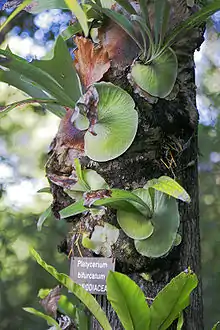 | |
| Platycerium bifurcatum from the Australian National Botanical Gardens, Canberra | |
| Scientific classification | |
| Kingdom: | Plantae |
| Clade: | Tracheophytes |
| Division: | Polypodiophyta |
| Class: | Polypodiopsida |
| Order: | Polypodiales |
| Suborder: | Polypodiineae |
| Family: | Polypodiaceae |
| Subfamily: | Platycerioideae |
| Genus: | Platycerium Desv. |
| Species | |
| |
Description
Platycerium sporophytes (adult plants) have tufted roots, growing from a short rhizome, and bear two types of fronds - basal and fertile fronds. Basal fronds are sterile, shield- or kidney-shaped, and laminate against the tree, to protect the fern's roots from damage and desiccation. In some Platycerium species, the top margin of these fronds will grow into an open crown of lobes; catching rainwater, falling forest litter, bird/animal droppings, and even an occasional fallen deceased animal, these plants build up their own “compost” system of nutrition over many years.
Fertile fronds bear spores on their undersurface, are dichotomous or antler-shaped, and jut out or hang from the rhizome. The spores are born in sporangia, clustered in large sori that are usually positioned on the lobes, or at the sinus between frond lobes.
Some species of Platycerium are solitary, having only one rhizome. Other species form colonies when their rhizomes branch, or when new rhizomes are formed from root tips. If the conditions are right, the spores will germinate naturally, on surrounding trees. Platycerium gametophytes are a small, heart-shaped thallus.
Platycerium have diverged into four natural groups. Several Platycerium are strongly adapted to xeric conditions, with a naturally drought-tolerant metabolism method having been reported for P. veitchii.[2]
Species
| Image | Name | Distribution |
|---|---|---|
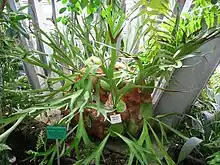 | Platycerium alcicorne Desv . | Madagascar, Comoros Island, Mauritius, Réunion, Seychelles, Kenya, Mozambique, Tanzania, Zimbabwe. |
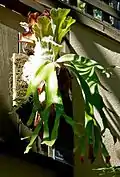 | Platycerium andinum Baker | Colombia, Bolivia and Peru. |
.jpg.webp) | Platycerium bifurcatum (Cav.) C. Chr . | Australia states of New South Wales, Queensland, Norfolk Island and Lord Howe Island. |
_(8752670563).jpg.webp) | Platycerium coronarium (J. Koenig ex O. F. Müll.) Desv . | Indonesia Sumatra, Kalimantan, West Java, Malaysia, Singapore, the Philippines, Thailand, Cambodia, Myanmar and Vietnam. |
| Platycerium ellisii Baker | Madagascar only in the provinces of Antsiranana and Toamasina. | |
 | Platycerium elephantotis Schweinf. | Angola, Benin, Burundi, Cameroon, Congo, Dem. Republic of Congo, Ethiopia, Gabon, Ghana, Guinea, Ivory Coast, Kenya, Liberia, Malawi, Mozambique, Nigeria, Rwanda, Senegal, Sierra Leone, Sudan and South Sudan, Tanzania, Togo, Uganda, Zambia, Zimbabwe, tropical Africa |
.JPG.webp) | Large antler fern (Platycerium grande (Fée) Kunze) | Philippines Province of Mindanao and Indonesia, in the Province of North Sulawesi and Gorontalo. |
 | Platycerium hillii T. Moore (Also referred to as a variety of Platycerium bifurcatum var. Hillii (T. Moore) Domin) | Australia Queensland, Papua New Guinea and Papua Indonesia. |
.jpg.webp) | Platycerium holttumii de Jonch. & Hennipman | Malaysia, Northern Peninsular, State of Perlis, Kedah, Perak and Kelantan, Thailand and Indochina. |
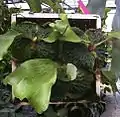 | Platycerium madagascariense Baker | Madagascar in the provinces of Antsiranana, Fianarantsoa and Toamasina. |
| Platycerium quadridichotomum (Bonap.) Tardieu | Madagascar only in Ankarana, Bemaraha, Bemarivo, Montagne d’Ambre including Fôret d'Ambre. | |
 | Platycerium ridleyi Christ | Malaysia, Southern Thailand, Indonesia Sumatra and Kalimantan. |
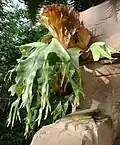 | Triangle antler fern (Platycerium stemaria (P. Beauv.) Desv.) | Angola, Benin, Cameroon, Central African Republic, Congo, Dem. Republic of Congo, Equatorial Guinea (incl. Bioko), Gabon, Guinea Bissau, Liberia, Senegal, Sudan and South Sudan, Uganda, Principe, Sao Tomé, tropical Africa. |
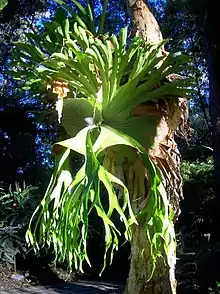 | Magnificent antler fern (Platycerium superbum de Jonch. & Hennipman) | Queensland and New South Wales. |
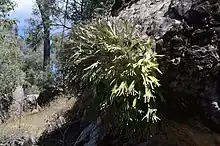 | Platycerium veitchii (Underw.) C. Chr. (Syn .: Platycerium bifurcatum subsp. Veitchii (Underw.) Hennipman & M. C. Roos) | Queensland. |
 | Platycerium wallichii Hook . | Northeastern India, Thailand, Laos, Malaysia, Myanmar and western Yunnan. |
 | Platycerium wandae Racib . | Papua New Guinea, Indonesia Papua and Maluku Island. |
| Platycerium willinckii T. Moore (Also referred to as a subspecies of Platycerium bifurcatum subsp. Willinckii (T. Moore) Hennipman & M. C. Roos ). | Sulawesi and Java | |
Cultivation
The species Platycerium bifurcatum and Platycerium superbum are commonly cultivated as ornamental plants. These oddly shaped ferns grow on trees and rocks and can be found in gardens, especially tropical gardens.
Staghorns can be propagated by spores produced on the underside of the fertile fronds. Colonial Platycerium can also be vegetatively propagated by carefully dividing large healthy ones into smaller, separate plants. These new plants can then be attached to board mounts or be strapped to trees until they take to the tree themselves.
A mature staghorn can grow more than 1 metre (3.3 ft) wide.
Gallery
References
- Hennipman, E. (1982). A monograph of the fern genus Platycerium (Polypodiaceae). Verhandelingen der Koninklijke Nederlandse Akademie van Wetenschappen, Afd. Natuurkunde. Tweede reeks. Amsterdam; New York: North-Holland. ISBN 0444855696.
- Kreier, Hans-Peter; Schneider, Harald (2006). "Phylogeny and biogeography of the staghorn fern genus Platycerium (Polypodiaceae, Polypodiidae)". American Journal of Botany. 93 (2): 217–225. doi:10.3732/ajb.93.2.217. ISSN 0002-9122. PMID 21646182.
- Holtum, Joseph A.M.; Klaus Winter (1999-01-01). "Degrees of crassulacean acid metabolism in tropical epiphytic and lithophytic ferns". Functional Plant Biology. 26 (8): 749–757. doi:10.1071/PP99001.



_IMG_3432_C.JPG.webp)